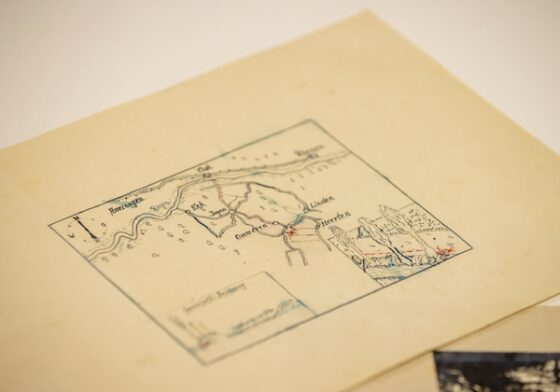Nazi treasure map goes on show at the Dutch national archives


A map which may show where Nazis buried millions of euros worth of jewelry, watches and diamonds which they stole from a bank in Arnhem has been made available to the public at the National Archive from Tuesday.
Thousands of items are have been added to the public archives in The Hague, including the map and other documents purporting to show the location of the treasure trove in the Betuwe region of Gelderland.
The gold, precious stone and other valuables were stolen from a branch of the Rotterdamsche Bank in Arnhem by German soldiers, who raided it after the building took a direct hit in 1944. They made off which their haul hidden in their clothes and later buried it in four munitions boxes in the vicinity of Ommen, Omroep Gelderland reported.
The story came to light shortly after World War II, when German soldier Helmut Sonder made a statement to investigators about being at the side of the road and watching ‘three of our troops… burying four boxes with valuable items such as golden watches and jewelry with precious stones’.
Sonder went on to tell Dutch civil servants that the solders had stolen their treasure in Arnhem some time before he came across them. ‘They said they had picked up the things when a bank safe had taken a direct hit and the jewelry and so on was scattered all around,’ the Telegraaf quoted the official statement as saying.
The statement led to a major hunt for the treasure in June 1947 but without result. Sonder was involved and gave directions which were then made into the map which has now been made public. It shows where the boxes are supposed to have been buried, next to a poplar tree.
A second attempt to find the treasure also failed, and Sonder’s tip was officially described as ‘dealt with’ and sent with the rest of the file to the archives, the Telegraaf said.
Specific
‘It gets your juices going,’ historian Joost Rosendaal, who was not aware of the story, told Omroep Gelderland. ‘It is a very specific map and that is special. But a lot is unclear and there are a lot of questions.’
Ommen was a battle zone at the time the haul was said to have been buried. ‘It could be that the treasure was buried and dug up two days later,’ he said. ‘I would not be at all surprised if it has disappeared.
Other items now accessible to the public include ministers from ministerial meetings in 1997 and documents about ‘problems’ at internment camps where Dutch nationals who sided with the Nazis were placed after the war.
The national archive contains 137 kilometres of documents, 15 million photographs and nearly 300,000 historical maps and drawings and 800 terabyte of digital files. It is accessible to everyone who wants to do research although some items are kept secret for up to 75 years
Thank you for donating to DutchNews.nl.
We could not provide the Dutch News service, and keep it free of charge, without the generous support of our readers. Your donations allow us to report on issues you tell us matter, and provide you with a summary of the most important Dutch news each day.
Make a donation